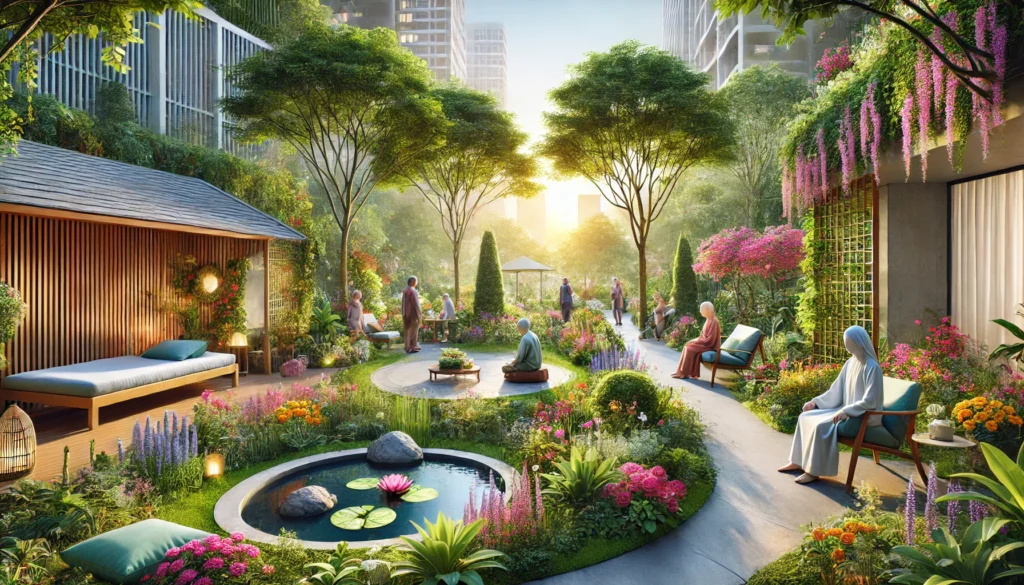In recent years, the connection between mental health and our environment has become more prominent, particularly the role that nature plays in promoting emotional well-being. Research has shown that spending time in green spaces, such as gardens, can reduce stress, anxiety, and depression, while boosting mood and overall mental health. In this article, we’ll explore how you can design a garden specifically to support mental health, turning your outdoor space into a personal sanctuary for relaxation and healing.
Why Green Spaces Matter for Mental Health
Spending time in nature has long been recognized for its calming effects. Gardens, in particular, offer a unique opportunity to engage with nature in a meaningful way, whether through tending to plants, enjoying the fresh air, or simply observing the beauty of greenery. The act of gardening itself can be meditative, providing a sense of purpose and accomplishment while fostering a connection to the earth.
Key Mental Health Benefits of Green Spaces:
- Reduces stress: Nature has a natural ability to lower cortisol levels (the stress hormone) and promote relaxation.
- Improves mood: Studies have shown that exposure to green spaces can help combat depression and anxiety by elevating mood.
- Increases mindfulness: Gardening encourages mindfulness by focusing attention on the present moment, which can help reduce symptoms of anxiety and depression.
- Boosts physical activity: Light gardening activities like planting, weeding, and watering keep the body moving, which is beneficial for both physical and mental health.
- Promotes social connection: Gardening can be a communal activity, helping to foster relationships with neighbors, friends, or family.
Designing a Garden with Mental Health in Mind
When designing a garden that supports mental health, the goal is to create a space that is calming, restorative, and invites relaxation. This involves selecting plants, layout, and features that promote peace and mindfulness while reducing feelings of stress and overwhelm.
1. Choose Calming, Sensory-Friendly Plants
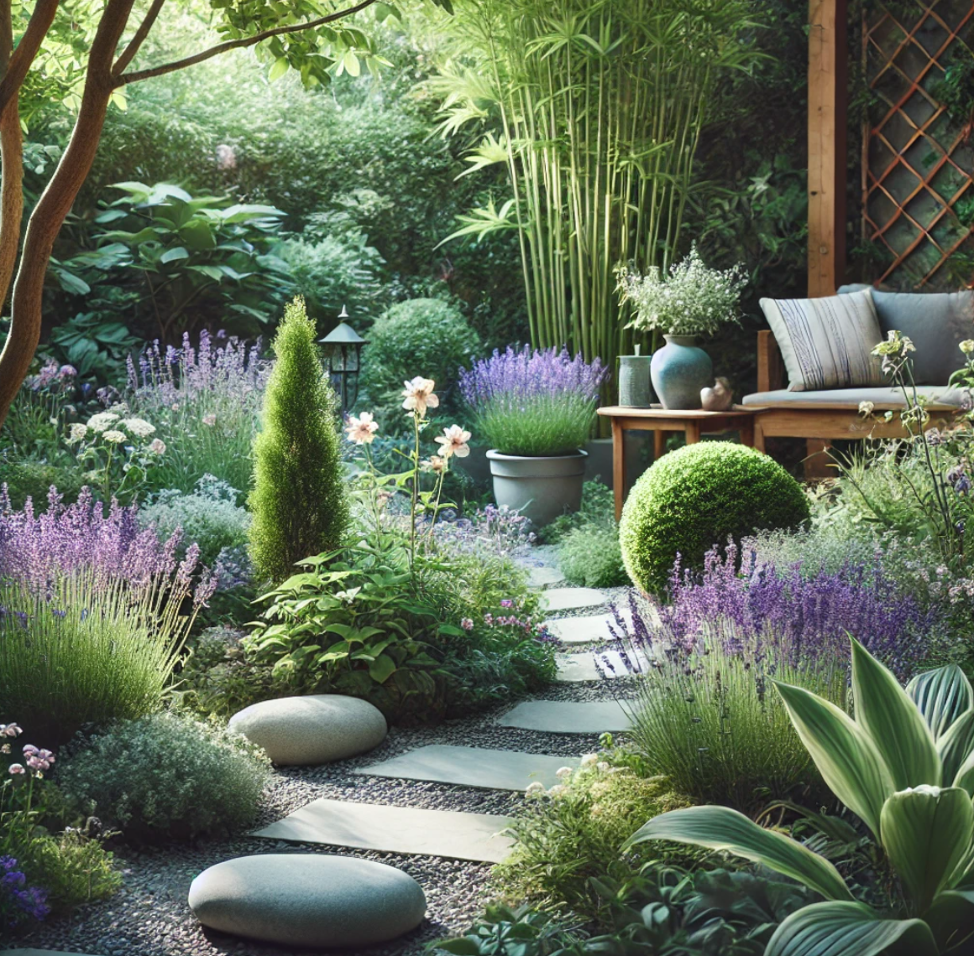
The choice of plants in your garden can significantly impact its therapeutic potential. Plants that appeal to the senses—whether through sight, touch, sound, or smell—help to create an immersive experience that can be deeply relaxing.
Sensory-Friendly Plant Choices:
- Lavender: Known for its calming scent, lavender is often used in aromatherapy to reduce anxiety and promote relaxation.
- Jasmine: This fragrant plant can improve mood and reduce stress.
- Bamboo: Bamboo adds a soothing rustling sound when the wind blows, creating a tranquil atmosphere.
- Ferns and moss: These soft, tactile plants invite touch, fostering a sensory connection with nature.
- Flowering perennials: Plants like echinacea, daisies, and sunflowers can add pops of color that brighten your mood.
- Herbs: Growing herbs such as mint, chamomile, and rosemary allows you to benefit from their aromatic and medicinal properties.
2. Create Zones for Relaxation and Reflection
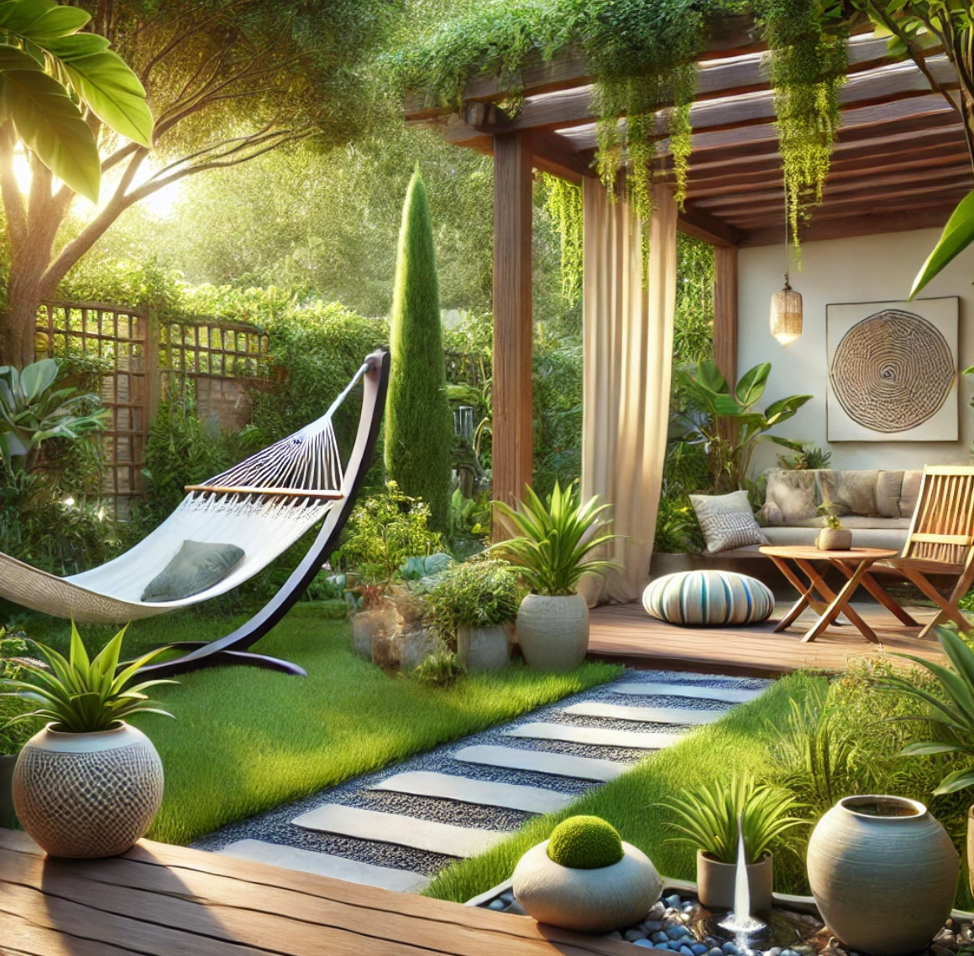
Your mental health garden should offer a variety of spaces where you can relax, reflect, and recharge. This can be achieved by creating different zones with specific purposes—whether it’s a seating area for meditation, a nook for reading, or a garden path for walking.
Tips for Creating Relaxation Zones:
- Add seating areas: Place comfortable seating like benches, hammocks, or outdoor chairs in quiet corners of the garden where you can unwind.
- Create a meditation spot: A small area with a cushion or mat for meditation, surrounded by plants or a water feature, can be your go-to space for mindfulness practice.
- Incorporate garden paths: Meandering garden paths encourage slow, mindful walking, which can help clear your mind and reduce stress.
- Install water features: The sound of water, whether from a small fountain, pond, or birdbath, has a calming effect and can help drown out background noise.
3. Use Colors to Evoke Calm and Positivity
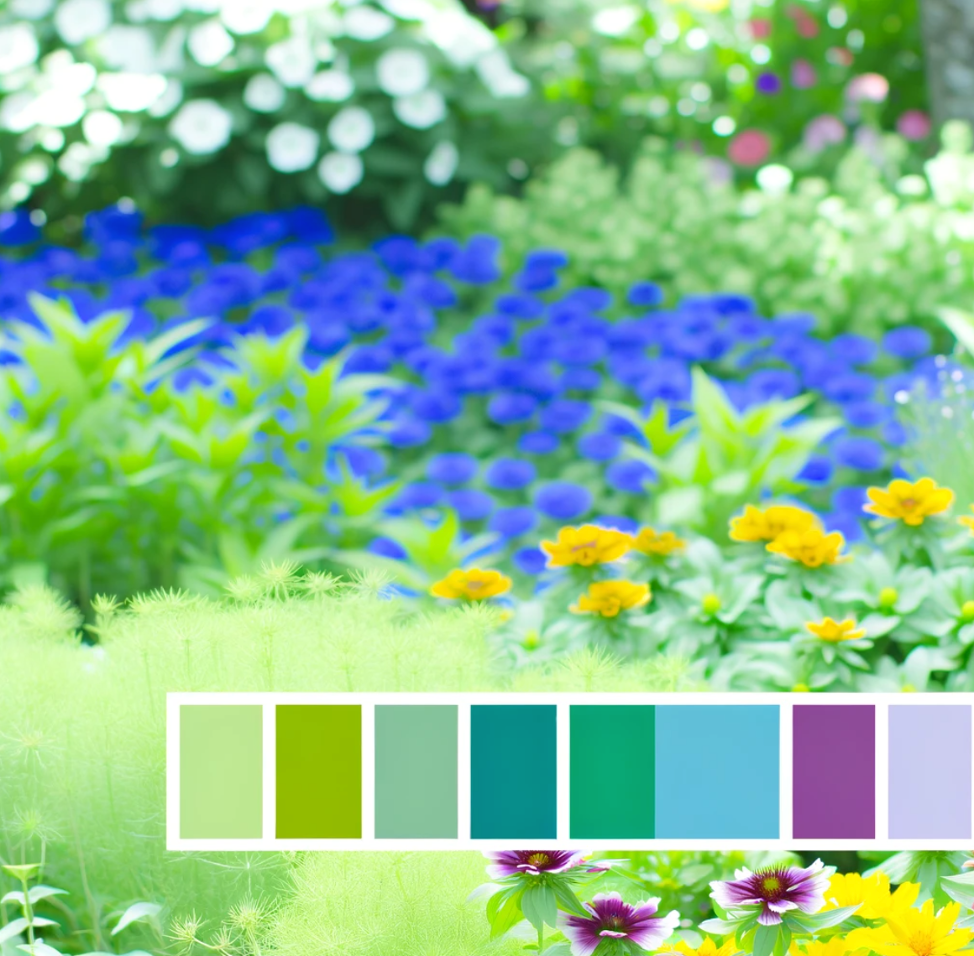
The color palette in your garden can have a profound effect on your mood. Cool tones like greens, blues, and purples are often associated with calm and tranquility, while bright colors like yellow and orange can evoke happiness and energy. Consider blending both cool and warm tones to create a balanced emotional experience in your garden.
Color Psychology in Garden Design:
- Green: The dominant color in nature, green is soothing and promotes feelings of peace and security.
- Blue: Often associated with calm and serenity, blue can help create a sense of space and openness in your garden.
- Purple: Purple flowers like lavender and lilac can evoke feelings of luxury and relaxation.
- Yellow and orange: These bright colors bring warmth and happiness, helping to lift your spirits.
4. Incorporate Elements of Nature for Grounding
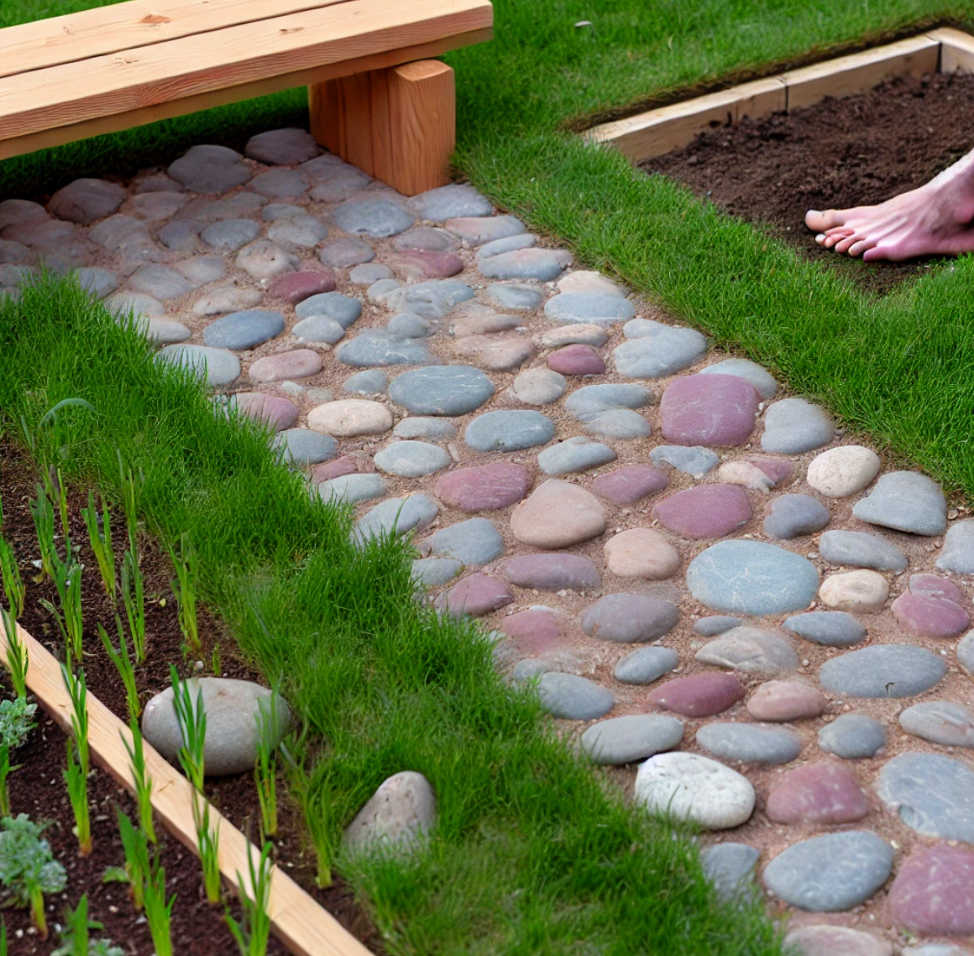
Grounding, also known as earthing, is the practice of reconnecting with the earth by coming into physical contact with natural elements. Including features in your garden that encourage grounding can help reduce stress and anxiety while enhancing your connection to nature.
Grounding Features for Your Garden:
- Barefoot walking paths: A pathway made of grass, smooth stones, or soft sand allows you to experience the grounding sensation of walking barefoot on natural surfaces.
- Soil interaction: Encourage direct contact with the soil by designing a space where you can garden with your hands. Planting and digging in the dirt can be therapeutic and soothing.
- Natural materials: Use natural materials like wood, stone, and water to create structures and features in your garden. A wooden bench or a stone pathway adds to the natural feel of the space.
5. Encourage Wildlife for a Sense of Connection
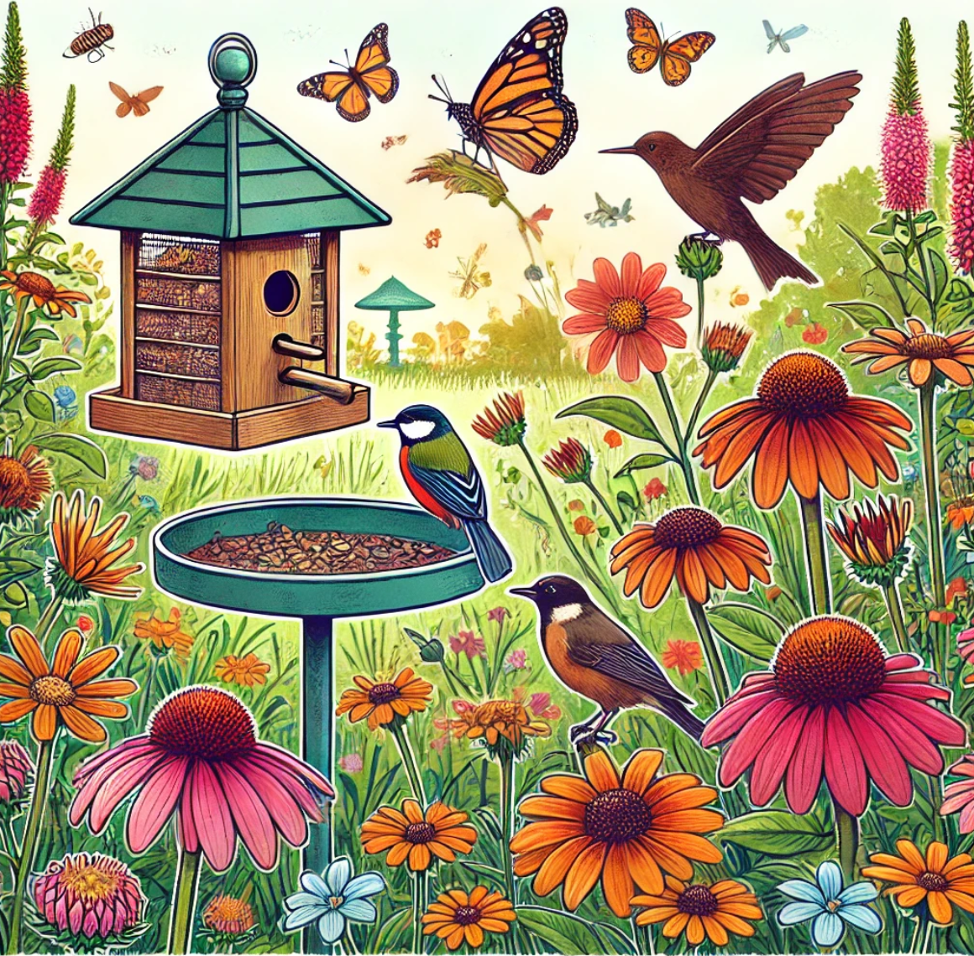
Welcoming wildlife into your garden can add an element of joy and connection to the world around you. Birds, butterflies, and other small creatures can bring life and energy to the space, enhancing the therapeutic experience.
Tips for Encouraging Wildlife:
- Plant pollinator-friendly flowers: Plants like echinacea, milkweed, and marigolds attract bees, butterflies, and hummingbirds, promoting biodiversity.
- Install bird feeders and birdbaths: These simple additions invite birds into your garden, creating opportunities to observe nature up close.
- Create a habitat for beneficial insects: Build insect hotels or leave piles of wood or rocks to provide shelter for beneficial insects like ladybugs and bees.
6. Minimize Stress with Low-Maintenance Design

A garden designed for mental health should be a space for relaxation, not a source of stress. To keep your garden easy to maintain, choose plants and features that are low-maintenance but still visually pleasing.
Low-Maintenance Garden Ideas:
- Perennials: These plants come back year after year, reducing the need for frequent replanting.
- Drought-tolerant plants: Choose plants like succulents, lavender, and native species that require less water and care.
- Automated watering: Consider installing a drip irrigation system to automate watering, reducing the amount of manual labor required to maintain the garden.
- Mulch: Using mulch in your garden beds helps retain moisture, reduce weeds, and improve soil health, all while cutting down on maintenance time.
The Importance of Mindfulness in Garden Design
Mindfulness is an important aspect of using your garden for mental health. By slowing down and paying attention to the sights, sounds, smells, and textures around you, you can immerse yourself in the present moment and reduce feelings of stress and anxiety. Incorporating mindfulness practices into your garden routine, such as mindful walking, meditation, or simply sitting and observing nature, can help enhance the therapeutic benefits of the space.
Simple Mindfulness Practices for Your Garden:
- Mindful observation: Take a few minutes each day to observe the plants, animals, and changes in your garden. Focus on the details—the texture of leaves, the movement of insects, the sound of rustling branches.
- Breathing exercises: Practice deep breathing while sitting in a quiet spot in your garden. Breathe in the fresh air, listen to the sounds of nature, and let your mind relax.
- Gratitude walks: Take a slow walk through your garden, focusing on feelings of gratitude for the beauty of nature and the peacefulness of the space you’ve created.
Final Thoughts
Designing a garden for mental health can transform your outdoor space into a sanctuary where you can relax, reflect, and recharge. By incorporating sensory-friendly plants, creating zones for relaxation, and focusing on mindfulness, you can create a space that nurtures both your mind and body. Whether you have a large yard or a small balcony, even a few thoughtful touches can make a big difference in promoting mental well-being through nature.

